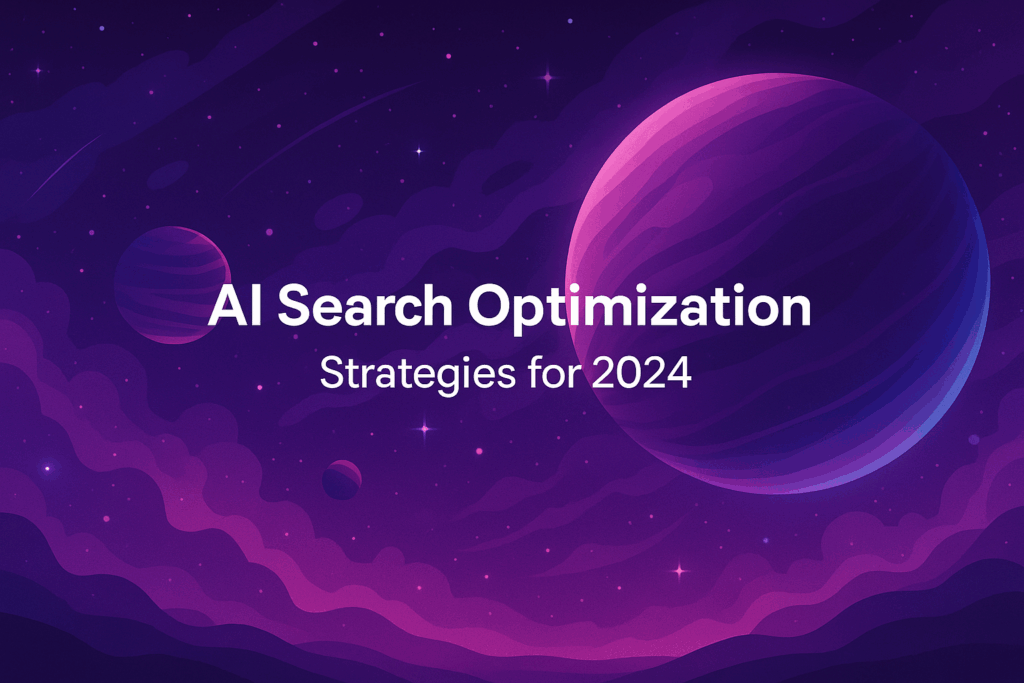/
May 31, 2025
/
rankgeo
Top 5 AI SEO Strategies to Improve Your GEO Visibility in 2025

Top 5 AI SEO Strategies To Improve GEO Visibility In 2025
The Ultimate Guide to Ranking in Generative Engines with AI-First Optimization
Table of Contents
Introduction: Why GEO Strategies Matter in 2025
In 2025, SEO is no longer about ranking first in Google—it’s about getting cited by AI.
Whether it’s ChatGPT, Claude, or Perplexity, generative engines are now key players in discovery. That means traditional keyword-first SEO won’t cut it.
To be found, you need GEO visibility: the ability for your content to be extracted, cited, and presented in LLM-generated answers.
This guide outlines 5 AI SEO strategies specifically designed to help you rank in this new world.
What is GEO Visibility?
GEO (Generative Engine Optimization) visibility is how likely your content is to appear or be cited in answers generated by AI search tools.
GEO visibility is influenced by:
How readable and structured your content is
Whether you address real prompts and questions
If you appear on AI-friendly sources
Schema, formatting, and clarity of data
The better your structure and semantic clarity, the higher your chances of being quoted or referenced by AI.
Strategy #1: Optimize for Prompt-Generated Citations
AI tools generate answers based on prompts. Your content must:
Include headers that match common prompt phrasing
Answer questions clearly and early
Use bullet points and numbered lists for extraction
Example Prompts:
“What are the best SEO strategies for AI search engines?”
“How do I improve GEO visibility in Perplexity?”
Use RankGeo’s prompt intelligence to align your content with what users are asking.
Strategy #2: Use AI-Structured Formatting for Readability
AI models prefer clean, predictable structures:
Use consistent
<h2>,<h3>,<p>hierarchyLimit paragraph length to 3-4 lines
Add schema markup (FAQ, Article, Breadcrumbs)
Formatting Blocks That Help:
Definition blocks
TL;DR summaries
Lists with inline bold keywords
Generative models extract from structure more than keyword density.
Strategy #3: Build Content Hubs with Topical Authority
Instead of one-off posts, create clusters of content around a theme.
Example:
Pillar: “What is GEO?”
Cluster: “GEO vs SAO”, “GEO Tools”, “Top AI SEO Strategies”
Use internal links with anchor text like:
“Learn more about GEO strategies”
“Compare GEO vs SAO here”
Topical consistency boosts both trust and relevance in AI outputs.
Strategy #4: Embed TL;DRs, Lists, and Data Blocks
AI engines love content they can scan quickly and extract from.
What to add:
TL;DR boxes at the top or bottom
Quick-hit bullet points after each section
Tables comparing strategies/tools
Quotes and citations with clear source labeling
Pro tip: Include publish/update dates to signal freshness.
Strategy #5: Submit and Syndicate to AI-Friendly Indexes
Don’t rely on Google alone to surface your site to AI.
Where to be present:
Hacker News, Reddit, Quora
Perplexity Labs (submit your blog)
Sites that generative models are trained on (e.g. StackExchange)
Also: Ensure robots.txt allows crawling and use sitemaps to expose all content.
RankGeo provides a visibility checklist for Claude, ChatGPT, and Gemini.
GEO and SAO: How They Work Together
| Strategy | SAO | GEO |
|---|---|---|
| Focus | Prompt matching | Engine structure & formatting |
| Goal | Get cited in AI answers | Get segmented or quoted in output |
| Key Engines | ChatGPT, Claude, Gemini | Perplexity, Claude, Arc Search |
You should always do both.
SAO makes your content understandable to AI, GEO makes it usable.
RankGeo’s Tools for Maximizing GEO Visibility
Features That Help:
Prompt alignment tools
Content readability analysis for LLMs
GEO scoring system
Structured data validator
Visibility tracking in Claude, Gemini, and Perplexity
Join over 200 projects already boosting their AI visibility using RankGeo.
Case Examples: GEO-Optimized Pages in Action
Example 1: Software Startup Blog
Used TL;DR, proper H2s, embedded tables
Now referenced in Claude and Perplexity
Example 2: Niche Finance Writer
Built a GEO-optimized cluster of 5 posts
Received citation from ChatGPT’s browsing tool
FAQ: AI SEO Strategies for 2025
What’s the most important thing for GEO visibility? Clean formatting + prompt alignment + clarity.
Can I GEO-optimize old content? Yes. Refresh structure, add TL;DR, improve formatting.
Is GEO only for big sites? No—small, clean, focused content ranks well in Perplexity and Claude.
Does RankGeo help with this? Yes. RankGeo was built for AI-first search strategies.
Join the GEO Optimization Movement
The future of SEO is structured, prompt-driven, and AI-visible.
If your content isn’t GEO-ready, it’s invisible to LLMs.
🚀 Join the RankGeo Waitlist
🌐 Unlock full GEO + SAO optimization today.
